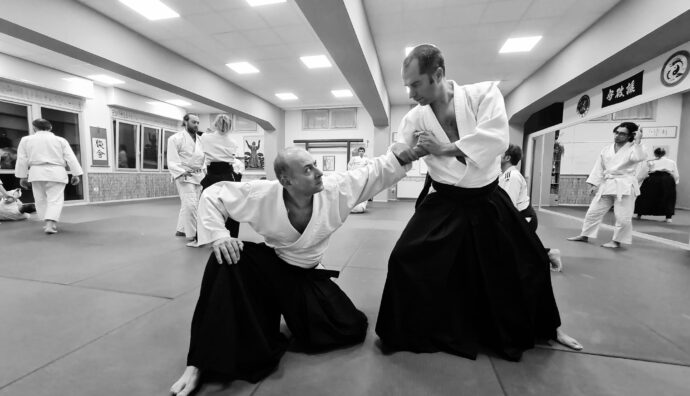The posts on the effectiveness of Martial Arts have definitely p**sed us off.
The average Aikidoka usually approaches the practice without a solid background in Martial Arts or combat skills.
Usually, the audience of an Aikido class has, at most, some experience in some discipline. In general, for almost everyone, a robust literacy is necessary, both motor and martial.
This is usually a good thing: as the proverb suggests, it is difficult to fill a cup if it is already full. On the other hand, the mental condition of the rookie practitioner is a kind of perpetual confusion.
Japanese nomenclature, new motor patterns, a different environment than the one we are used to, minimal but clear rules of etiquette… All translated into glances that continually seek the teacher as if to say: “Am I doing right?”
In the exchanges between nage and uke, uke goes to the ground because… he/she has to. And it is already a great result if nage has correctly strung together the entire sequence: first the elbow, then the wrist, then the movement…
Every time we are in a context in which we have to learn something new and to which we are not accustomed, we become children again. A good teacher must acknowledge the child he is addressing and know how to encourage him for small progress, even if in the meantime the shell of that child has grown up and is a mature individual.
Thus, in the mind of the Aikido practitioner, an idea is borne that his/her partner ends up on the ground willingly or by force. In other words, one becomes convinced that the practice is somehow divided between the execution of a form and that internalizing it means becoming capable of leaving no escape for one’s uke.
Both in Ju Jutsu and in its nephew who went to the school for good manners that is Aikido, one experiences definitiveness. As with De Beers diamonds’ commercial, even a joint leverage is forever, as is a pin on the ground or a line of imbalance.
However, it must be remembered that, like any other traditional Budo, Aikido has been clearly structured as a tool for personal improvement, as a methodology to counter an egoic and selfish vision of existence.
Slowly slipping into superimposing a supposed technical mastery with the ability to win everything and everyone in any situation is nothing more than reaffirming one’s ego – in addition to not having the slightest awareness of what a condition of critical threat on a physical level is.
Perhaps we need to find the courage to reaffirm that it is from the moment in which he/she decides to launch the attack that uke agrees to remain within the dynamics of the execution of a technique or a concatenation of techniques, even casual ones.
And if we struggle to call this willingness “love”, at least let’s remember that we are not obliged by the doctor to conclude the action “by force”.
Yet, whether we watch six-year-old children perform ikkyo ura or beginner adults or expert practitioners pushed to the limit of their psychophysical endurance, we will often see men and women who are extremely composed in their etiquette, committed to training, loyal in their relationships in the Dojo, twisting elbows and wrists of their unfortunate companions.
We ask ourselves, cyclically and on multiple levels, how and to whom to effectively communicate Aikido and Budo in general.
Probably a convincing answer also comes through an environment in which learning a clear and well-executed technical language, allows us to escape the paradigm of “by force”, then leaving the individual with the responsibility of understanding that if he or she manages to perform increasingly complex movements “for love” on a tatami, then he or she can remember that the same principle works outside as well.

